Punjab State Board PSEB 10th Class Maths Book Solutions Chapter 10 Circles Ex 10.2 Textbook Exercise Questions and Answers.
PSEB Solutions for Class 10 Maths Chapter 10 Circles Ex 10.2
In Question 1 to 3, choose the corred option and give justification.
Question 1.
From a point Q, the length of the tangent to a circle is 24 cm and the distance of Q from the centre is 25 cm. The radius of the circle is
(A) 7 cm
(B) 12 cm
(C) 15 cm
(D) 24.5 cm
Solution:
A circle with centre O from a point, Q the length of the tangent to a circle is 24 cm and distance of Q from the centre is 25 cm.
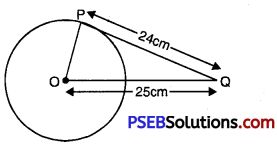
∴ ∠QPO = 90°
Now, in right angled ∠OPQ,
OQ2 = PQ2 + OP2
(25)2 = (24)2 + OP2
Or 625 = 576 + OP2
Or OP2 = 625 – 576
Or OP2 = 49 = (7)2
Or OP = 7 cm
∴ Option (A) is correct.
![]()
Question 2.
In Fig., if TP and TQ and tangents to a circle with centre O so ∠POQ = 110°, then ∠PTQ is equal to
(A) 60°
(B) 70°
(C) 80°
(D) 90°
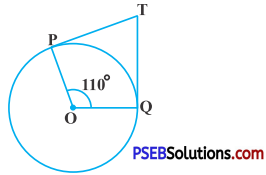
Solution:
In figure, OP is radius and PT is tangent to circle.
∠OPT = 90°
Similarly, ∠OQT = 90° and ∠POQ = 110° (Given)
Now, POQT is a Quadrilateral.
∴ ∠POQ + ∠OQT + ∠PTQ + ∠TPO = 360°
110° + 90° + ∠PTQ + 90° = 360°
Or ∠PTQ + 290° = 360°
Or ∠PTQ = 360° – 290°
Or ∠PTQ = 70°
∴ Option (B) is correct.
![]()
Question 3.
In tangents PA and PB from a point P to a circle with centre O are inclined to each other at angle of 800, then LPOA is equal to
(A) 50°
(B) 60°
(C) 70°
(D) 80°
Solution:
In given firgure, OA is radius and AP is a tangent to the circle.
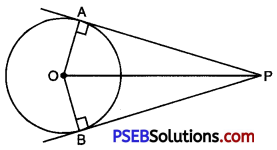
∴ ∠OAP = 90°
Similarly, ∠OBP = 90°
Now, in right angled ∆PAO and ∆PBO
∠PAO = ∠PBO = 90°
OP = OP (Common side)
OA = OB (radii of same Circle)
∴ ∆PAO ≅ ∆PBO [RHS congruence]
∴ ∠AOP = ∠BOP [CPCT]
Or ∠AOP =∠BOP = \(\frac{1}{2}\) ∠AOB
Also, In Quad. OAPB,
∠OBP + ∠BPA + ∠PAO + ∠AOP = 360°
90° +80° +90° + ∠AOB = 360°
∠AOB = 360° – 260°
∠AOB = 100°
Form (1) and (2), we get
∠AOP = ∠BOP = \(\frac{1}{2}\) × 100° = 50°
∴ Option (A) is correct.
![]()
Question 4.
Prove that, the tangents drawn at the ends of a diameter of a circle are parallel.
Solution:
Given: A circle with center O and AB as its diameter l and m are tangents at points A and B.
To Prove: l || m
Proof: OA is the radius and l is the tangent to the circle.
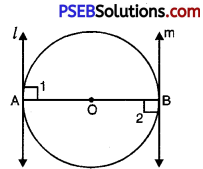
∴ ∠1 = 90°
Similarly, ∠2 = 90°
Or ∠1 = ∠2 = 90°
But these are alternate angles between two lines, when one transversal cuts them.
∴ l || m
Hence, tangents drawn at the ends of a diameter of a circle are parallel.
Question 5.
Prove that the perpendicular at the point of contact to the tangent to a circle passes through the centre.
Solution:
Given. A circle with centre O. AB its tangent meet circle at P.
i.e., P is the point of contact.
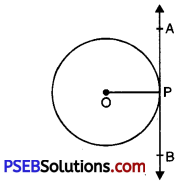
To Prove: Perpendicular at the point of contact to the tangent to a circle passes through the centre.
Construction: Join OP.
Proof: The perpendicular to a tangent line AB through the point of contact passes through the centre of the circle because only one perpendicular, OP can be drawn to the line AB through the point P.
Hence, perpendicular at the point of contact to the tangent to a circle passes through the centre.
![]()
Question 6.
The length of a tangent from a point A at a distance 5 cm. from the centre of the circle is 4 cm. Find the radius of the circle.
Solution:
A circle with centre ‘O’ A is any point outside the circle at a distance of 5 cm from the centre.
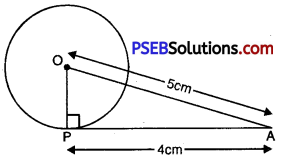
Length of tangent = PA = 4 cm
Since, OP is the radius and PA is the tangent to the circle.
∠OPA = 90°
Now, in right angled ∠OPA.
Using Pythagoras Theorem.
OA2 = OP2 + PA2
(5)2 = OP2 + (4)2
Or OP2 = 25 – 16
Or OP2 = 9 = (3)2
Or OP = 3 cm.
Hence, radius of the circle is 3 cm.
Question 7.
Two concentric circles are of radii 5 cm and 3 cm. Find the length of Ihe chord of the larger circle which touches the smaller circle.
Solution:
Two concentric circles having same centre O, and radii 5 cm and 3 cm respectively. Let PQ be the chord of larger circle
but tangent to the smaller circle.
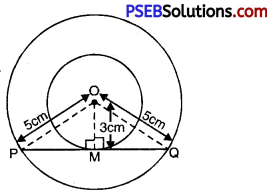
Since, OM be the radius of smaller circle and PMQ be the tangent.
∴ ∠OMP = ∠OMQ = 90°
Consider, right angled triangles OMP and OMQ,
∠OMP = ∠OMQ = 90°
OP = OQ [radii of same circle]
OM = OM [common side]
∴ ∆OMP ≅ ∆OMQ [RHS congurence]
∴ PM = MQ [CPCT]
Or PQ = 2PM = 2MQ
Now, in right angled ∆OMQ.
Using Pythagoras Theorem,
OQ2 = OM2 + MQ2
(5)2 = (3)2 + (MQ)2
Or MQ = 25 – 9
Or MQ2 = 16 = (4)2
Or MQ = 4 cm
Length of chord PQ = 2 MQ = 2 (4) cm = 8 cm
Hence, length of required chord is 8 cm.
![]()
Question 8.
A quadrilateral ABCD is drawn to the circumscribe a circle (see figure). Prove that AB + CD = AD + BC.
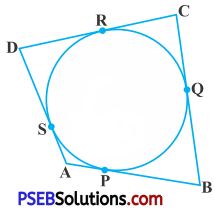
Solution:
Given: A Quadrilateral ABCD is drawn to circumscribe a circle.
To Prove: AB + CD = AD + BC
Proof: Since the lengths of tangents drawn from an external point to a circle are equal. Now, B is any point outside the circle and BP : BQ are tangents to the circle.
∴ BP = BQ ……………(1)
Similarly, AP = AS ………….(2)
and CR = CQ …………..(3)
Also, DR = DS ………….(4)
Adding (1), (2), (3) and (4), we get
(BP + AP) + (CR + DR) = (BQ + CQ) + (AS + DS)
AB + CD = BC + AD
is the required result.
Question 9.
In figure, XY and X’Y’ are two parallel tangents to a circle with centre O and another tangent AB with point of contact C
intersecting XY at A and X’Y’ at B. Prove that ∠AOB = 90°.

Solution:
Given: A circle with centre O having two parallel tangents XY and X’Y’ and= another tangent AB with point of contact C
intersecting XY at A and X’Y’ at B.
To Prove: ∠AOB = 90°
Contruction: Join OC, OA and OB.
Proof: Since the lengths of tangents drawn from an external point to a circle are equal.
Now, A is any point outside the circle from two tangents PA and AC are drawn to the circle.
∴ PA = AC
Also, in ∆ POA and ∆ AOC,
PA = AC (Proved)
OA = OA (common side)
OP = OC (radii of same circle)
∴ ∆POA ≅ ∆AOC [SSS congruence]
and ∠PAO = ∠CAO [CPCT]
Or ∠PAC = 2 ∠PAO = 2 ∠CAO ……………(1)
Similarly, ∠QBC = 2∠OBC = 2 ∠OBQ ………………(2)
Now, ∠PAC + ∠QBC = 180°
[Sum of the interior angles on the same side of transversal is 180°]
Or 2∠CAO + 2∠OBC = 180° [Using (1) & (2)]
Or ∠CAO + ∠OBC = 180 = 90° …(3)
Now, in ∆OAB,
∠CAO + ∠OBC + ∠AOB = 180°
90°+ ∠AOB = 180° [Using (3)]
Or ∠AOB = 180° – 90° = 90°
Hence, ∠AOB = 90°.
![]()
Question 10.
Prove that the angle between the two tangents drawn from an external point to a circle is supplementary to the angle subtended by the line segment joining the points of contact at the centre. [Pb. 20191
Solution:
Given. A circle with centre O. P is any point outside the circle PQ and PR are the tangents to the given circle from point P.
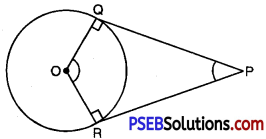
To Prove. ∠ROQ + ∠QPR = 180°
Proof. OQ is the radius and PQ is tangent from point P to the given circle.
∴ ∠OQP = 90° ………..(1)
[∵ The tangent at any point of a circle is perpendicular to the radius through the point of contact]
Similarly, ∠ORP = 90°
Now, in quadrilateral ROQP,
∠ROQ + ∠PRO + ∠OQP + ∠QPR = 360°
Or ∠ROQ + 90° + 90° + ∠QPR = 360° [Using (1) & (2)]
Or ∠ROQ + ∠QPR + 180 = 360°
Or ∠ROQ + ∠QPR = 360° – 180°
Or ∠ROQ + ∠QPR = 180°
Hence, the angle between the two tangents drawn from and external point to a circle is supplementary to angle subtended by the line segment joining the pnts of contact at the centre.
Question 11.
Prove that the parallelogram circumscribing a circle is a rhombus.
Solution:
Given: A parallelogram ABCD circumscribed a circle with centre O.
To Prove: ABCD is a rhombus.
Proof: Since the lengths of tangents drawn from an external point to a circle are equal. Now, B is any point outside thé circle and BE; BF are tangents to the circle.

To Prove: ABCD is a rhombus.
Proof: Since the lengths of tangents drawn from an external point to a circle are equal. Now, B is any point outside thè circle and BE; BF are tangents to the circle.
∴ BE = BF
Similarly AE = AH ……………(2)
and CG = CF
Also DG = DH
Adding (1), (2), (3) and (4), we get
(BE + AE) + (CG + DG) = (BF + CF) – (AH + DH)
Or AB + CD = BC +AD ……….(5)
Now, ABCD is a parallelogram, (Given)
∴ AB = CD and BC = AD …………(6)
From (5) and (6), we get
AB + AB = BC + BC
Or 2AB = 2BC or AB = BC
Or AB = BC = CD = AD
∴ ABCD is a rhombus.
Hence, parallelogram circumscribing a circle is a rhombus.
![]()
Question 12.
A triangle ABC is drawn to circumscribe a circle of radius 4 cm such that the segments BD and DC into which BC is divided by the point of contact D are of lengths 8 cm and 6 cm respectively (see Fig). Find the sides AB and AC.
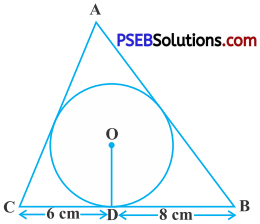
Solution:
A triangle ABC is drawn to circumscribe a circle of radius 4 cm and the sides BC, CA, AB of ∆ABC touch the circle at
D, E, F respectively. Since the lengths of tangents drawn from an external point to a circle are equal.
∴ AE = AF = x cm(say)
CE = CD = 6 cm (Given)
and BF = BD = 5 cm
Since the tangent at any point of a circle is perpendicular to the radius through the point of contact.
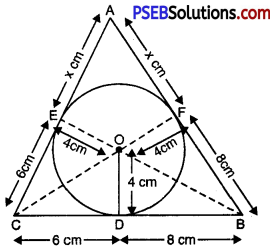
∴ OD ⊥ BC; OE ⊥ AC and OF ⊥ AB.
Also, OE = OD = OF = 4 cm.
Consider, ∆ABC
a = AC = (x + 6) cm ;
b = CB = (6 + 8) cm = 14 cm
c = BA = (8 + x) cm
S = \(\frac{a+b+c}{2}\)
∴ S = \(\frac{x+6+14+8+x}{2}\) = \(\frac{2 x+28}{2}\) = (x + 14)
area (∆ABC)= \(\sqrt{\mathrm{S}(\mathrm{S}-a)(\mathrm{S}-b)(\mathrm{S}-c)}\)
= \(\sqrt{\begin{array}{r}
(x+14)(x+14-\overline{x+6}) \\
(x+14-14)(x+14-\overline{8+x})
\end{array}}\)
= \(\sqrt{(x+14)(8)(x)(6)}\)
= \(\sqrt{48 x^{2}+672 x}\) cm2 ………………(1)
area (∆OBC) = \(\frac{1}{2}\) × base × altitude
= \(\frac{1}{2}\) × 14 × 4 = 28cm2 …………….(2)
area(∆BOA)= \(\frac{1}{2}\) × base × altitude
= \(\frac{1}{2}\) × (8 + x) × 4 = 28cm2…………….(3)
area (∆AOC) = \(\frac{1}{2}\) × base × altitude
= \(\frac{1}{2}\) × (6 + x) × 4 = 28cm2 …………….(4)
From the figure, by addition of areas, we have
Or (∆ABC) = ar (∆OBC) + ar (∆BOA) + ar (∆AOC)
\(\sqrt{48 x^{2}+672 x}\) = 28 + 16 + 2x + 12 + 2x
Or \(\sqrt{48 x^{2}+672 x}\) = 4x + 56
Or 48x2 + 672x =4[x+ 14]
Squaring both sides, we get
Or 48x2 + 672x = 16 (x + 14)2
Or 48x (x + 14) = 16(x + 14)2
Or 3x = x + 14
Or 2x = 14
Or x = \(\frac{14}{2}\) = 7
∴ AC = (x + 6) cm = (7 + 6) cm= 13 cm
and AB = (x + 8) cm = (7 + 8) cm = 15 cm
Hence, AB = 15 cm and AC = 13 cm.
![]()
Question 13.
Prove that opposite sides of a quadrilateral circumscribing a circle subtend supplementary angles at the centre of the circle.
Solution:
Given:
A quadrilateral PQRS circumscribing a circle having centre O. Sides PQ, QR, RS and SP touches the circles at L, M, N, T
respectively.
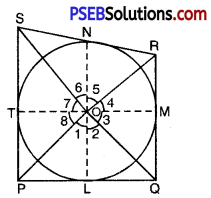
To Prove:
∠POQ + ∠SOR = 180°
and ∠SOP + ∠ROQ = 180°
Construction:
Join OP, OL, OQ, 0M. OR, ON, OS, OT
Proof: Since the two tangents drawn from an external point subtend equal angles at the centre.
∴ ∠2 = ∠3; ∠4 = ∠5 ; ∠6 = ∠7; ∠8 = ∠1
But, sum of all angles around a point is 360°
∴ ∠1 + ∠2 + ∠3 + ∠4 + ∠5 + ∠6 + ∠7 + ∠8 = 360°
Or ∠1 + ∠2 + ∠2 + ∠5 +∠5 + ∠6 + ∠6 + ∠1 = 360°
Or 2(∠1 + ∠2 + ∠5 + ∠6) = 360°
Or (∠1 + ∠2) + (∠5 + ∠6) = \(\frac{360^{\circ}}{2}\) = 180°
Or ∠POQ + ∠SOR = 180°
Similarly, ∠SOP + ∠ROQ = 180°
Hence, opposite sides of a quadrilateral circumscribing a circle subtend supplementary angles at the centre of the circle.
